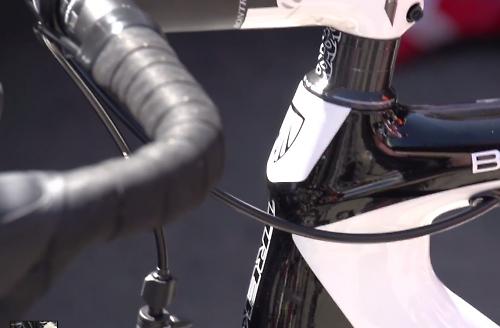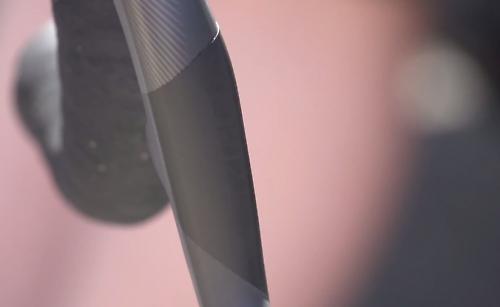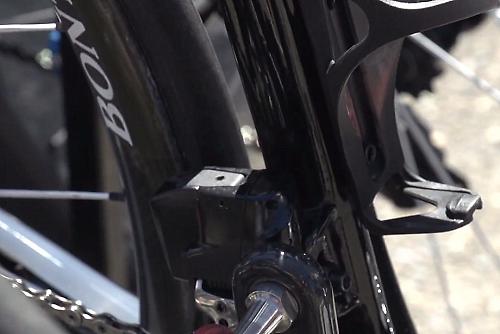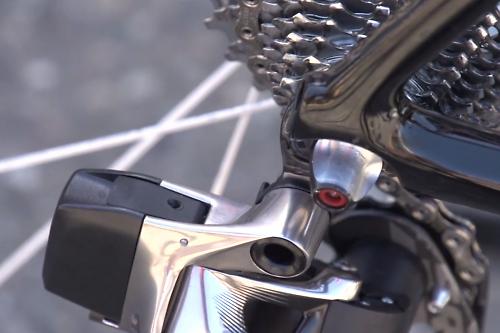- News
- Reviews
- Bikes
- Components
- Bar tape & grips
- Bottom brackets
- Brake & gear cables
- Brake & STI levers
- Brake pads & spares
- Brakes
- Cassettes & freewheels
- Chains
- Chainsets & chainrings
- Derailleurs - front
- Derailleurs - rear
- Forks
- Gear levers & shifters
- Groupsets
- Handlebars & extensions
- Headsets
- Hubs
- Inner tubes
- Pedals
- Quick releases & skewers
- Saddles
- Seatposts
- Stems
- Wheels
- Tyres
- Tubeless valves
- Accessories
- Accessories - misc
- Computer mounts
- Bags
- Bar ends
- Bike bags & cases
- Bottle cages
- Bottles
- Cameras
- Car racks
- Child seats
- Computers
- Glasses
- GPS units
- Helmets
- Lights - front
- Lights - rear
- Lights - sets
- Locks
- Mirrors
- Mudguards
- Racks
- Pumps & CO2 inflators
- Puncture kits
- Reflectives
- Smart watches
- Stands and racks
- Trailers
- Clothing
- Health, fitness and nutrition
- Tools and workshop
- Miscellaneous
- Buyers Guides
- Features
- Forum
- Recommends
- Podcast
TECH NEWS
Video: SRAM electronic groupset is WIRELESS
SRAM may not have been very good (intentionally or otherwise) at keeping their long awaited electronic groupset secret, but they have been better at keeping the fact that it is wireless under wraps - until now.
Earlier this week we got our first real look at the groupset via a CGN video. Now those decoy wires (c’mon SRAM it’s only a groupset) have come off and GCN have got a lot closer still, talking to riders on the Bissell Development team who have been using the new groupset for some time it would appear.
So what do we learn?
It’s not Double Tap . You press once on one shifter to change up at the back, once on the other to change down and both at the same time to shift at the front. As has been pointed out you can already program Shimano Di2 to do this. Double Tap would have been really hard to program and operate in an electronic system and has always had at least as many detractors as fans.
There is no battery unit so the batteries for the front and rear shifters are in the motors. The levers must also contain batteries to power the wireless transmitters.

Look ma, no wires. Only a brake cble connects the front and rear of the Bissell team bike,
It’s robust and reliable, say the Bissell riders. Well, they would. It will have to be, though: SRAM can’t afford any more recall disasters. However, it bears repeating that their disc brake woes stem not from poor design, but a failure of quality control, and that’s something that only shows up in production.
“it’s more aero,” says Tao Geoghan Hart . Marginal gains and all that. There must be some advantage, but given that so many bikes have internally routed cables only a wind tunnel could tell us how much.

What's under the tape on the brake lever? GCN suspects an embossed 'Red' logo.
The Ant+ or Bluetooth (or both) wireless system used gives exciting possibilities for a head unit to give you lots more information about what your bike is doing . Or at least what its gears are doing.
It could be lighter than the equivalent Shimano or Campagnolo. The jury is out on this one as the size of the motors plus batteries on the front and rear deraileurs doesn’t suggest lightness. Looks can be deceiving though, and SRAM have done away with all of those heavy cables. Our guess is that is it lighter than competitor systems, but not by much.
So what are the advantages of a wireless electronic groupset over a wired one?
Well, it looks cooler.
It’s marginally more aero.
It should be marginally lighter.
SRAM could (in theory) incorporate a hydraulic brake master cylinder without the aesthetic implications that affect the current SRAM 22 hydraulic levers.
Did we mention it looks cooler?
Erm…
And the disadvantages?
We don’t know yet. So long as the system is reliable, robust and weatherproof it’s hard to think of any.
The big worry for users will probably be that the signal from the levers to the mechs could be disrupted, but unlike say, a GPS, this is a system in which the constituent parts only need to talk to each other when you want to make them do something: change gear. So even if the system did suffer from interference or disruption to affect performance it would have to happen at the same time you were trying to change gear.

The front derailleur has a hole where the previous decoy wires went in. Could it be a charge port?
On the other hand sceptics will point out that an ethernet cable generally gives a faster and more reliable connection than wi-fi. You don't need to operate your gears from your front room when your bike is in the hall so if you're going to use electronic gears why step away from the tried and true? That will probably be the biggest sales challenge for SRAM when it comes to selling the groupset after market.
What the point of the decoy wires was and why they’ve now come off (maybe they fell off?) only SRAM’s marketing department and the Bissell Development team can truly tell us. That world’s bike media has written about SRAM electronic twice in a week rather than once probably tells us all we need to know.

It's easy to imagine the battery being inside that black housing. Perhaps you flip up the latch and pull it off for recharging.
That SRAM have opted for a wireless set up should be no surprise: many in the industry have predicted that is exactly what they would do. Indeed there would be very little point in them going down the electronic route if the final offering was going to be a late-to-the-party product that offered no more than Shimano Di2 or Campagnolo EPS. Earlier this week James Huang, BikeRadar’s technical editor in the US produced a masterful piece of work on the new groupset, seeing through all those decoy wires, and explaining why SRAM electronic had to be wireless. He even had patent drawings to hand.
One of the other clinchers for Huang that the new groupset was wireless was that SRAM have plenty of form when it comes to choreographing a big launch with ‘leaks’, staged spy shots, and even dummied up prototypes. He might also have mentioned (but didn't) that an in-depth James Huang exclusive is often one of the final moves in SRAM’s elaborate launch rituals.
Unknowns
What the likely battery life is we don’t know, nor do we know for sure how the batteries will be charged. Will they be easily removable for external charging or are those holes in the mech bodies in fact charge points?
When are you likely to see SRAM wireless in your local bikes hop? Bissell’s Geoghan Hart reckons it’s a year away; all the kerfuffle of the past few days suggests it could be here some time sooner.
If it’s spotted on a WorldTour bike in the near future then we’ll expect to see it at Eurobike this year; if not, then Geoghan Hart may be right. However, the clock is ticking under article 1.3.007 of the UCI technical regulations which says that prototype equipment can only be used if it is going to be available to buy within nine months of its first use in a race.
Patent pending
So we've been having a trawl of the US patent office website this morning, and turned up SRAM's pending patent for "electronic shifting systems and methods" filed on 12 December 2012. It's clear SRAM have been working on this a long time and they've done well to keep it under wraps until now.
.jpg)
Here's the summary of the patent: "The invention provides a wireless control system for a bicycle, including at least one shift actuator generating an input signal when actuated and a master control unit transmitting a shift signal responsive to the input signal. At least one electromechanical gear changer is provided and includes a gear changer control unit. The gear changer control unit receives the shift signal from the master control unit and controls at least one electromechanical gear changer corresponding to the received shift signal. The gear changer control unit listens for the shift signal during a part of an awake mode cycle time, the master control unit transmitting the shift signal for a message duration time which is greater than the awake mode cycle time."
Regarding battery life, it appears the system will conserve power by "turning the transmitter and receiver off when not in use and by power cycling the transmitter and receiver when the bicycle is active" with the addition of a 'wake sensor' which puts the system into a sleep mode when not being used.
.jpg)
As for the wireless protocol, the patent indicates a " 2.4 GHz transceiver utilising AES encryption and DSS spread spectrum technology supporting 16 channels and the IEEE 802.15.4 communication protocol."
Interestingly, it looks like the groupset will be able to communicate with devices like a smart phone or cycling computer. "It is also possible for the present system 22 to communicate with other third party devices using standard protocols such as ANT or Bluetooth Smart (BTLE)."
road.cc's founder and first editor, nowadays to be found riding a spreadsheet. Tony's journey in cycling media started in 1997 as production editor and then deputy editor of Total Bike, acting editor of Total Mountain Bike and then seven years as editor of Cycling Plus. He launched his first cycling website - the Cycling Plus Forum at the turn of the century. In 2006 he left C+ to head up the launch team for Bike Radar which he edited until 2008, when he co-launched the multi-award winning road.cc - finally handing on the reins in 2021 to Jack Sexty. His favourite ride is his ‘commute’ - which he does most days inc weekends and he’s been cycle-commuting since 1994. His favourite bikes are titanium and have disc brakes, though he'd like to own a carbon bike one day.
Latest Comments
- momove 17 min 48 sec ago
Precisely on point about the parking. There'd be almost no issues if all the space allocated to car parking was provided for bike parking instead....
- Pedal those squares 32 min 18 sec ago
IMHO he should be prosecuted to the full extent possible and band from all sporting events for a VERY long time. Otherwise there is no real...
- Spangly Shiny 48 min 21 sec ago
I'm pretty sure the dear lady is still very much alive and kicking. Reports of her demise are at least, a tad premature.
- chrisonabike 47 min 43 sec ago
What is "progress" though?...
- Secret_squirrel 2 hours 52 min ago
Thats if you believe that a slightly bigger bearing surface translates in any meaningful way to "pedaling stiffness" which to my mind is the...
- chrisonabike 2 hours 58 min ago
Everyone carrying more / brighter searchlights will fix things? Perhaps it helps sometimes, but I think this leads to other issues. We're already...
- SecretSam 3 hours 26 sec ago
Lake's naming and sizing: never knowingly comprehensible. Good shoes, baffling range.
- hawkinspeter 3 hours 3 min ago
Yeah, I doubt if Arron Banks would be happy visiting "little Somalia" (as he referred to Bristol) and certainly I don't think Bristol's residents...
- ChasP 3 hours 40 min ago
It could be used as a reliable comparison without any calculations.







Add new comment
64 comments
It'd be a bit weird to go to all the trouble of having wireless shift signals and then join things up with wires
Where do the CTRL-ALT-DEL buttons go?
Im not convinced this is fixing a real world problem - its certainly going to get people talking but boy they will need to get it right.
Personally the idea of 4 separate batteries on a bike has already slowed me down a bit!...
It'll use a proven industrial based wireless protocol, like Zigbee thats mentioned above, or possibly something better.
We run a multimillion pound manufacturing plant with similar stuff, and safety critical applications, your gears will be fine.
Looks good to me but I too have concerns about multiple batteries. Can't say the front shifting scheme impresses me. I know you'd get used to it but seems awkward.
I'd be very surprised if the shifters use an external rechargeable battery pack, that would be extreme overkill from a weight and complexity perspective.
I strongly suspect these will take coin cells, just like Garmin's Edge computer remote switches/HRM straps do. Those can last in excess of a year from a single battery, and cost pennies to replace.
Gizmo - if you're worried about cable stretch on electronic shifters (wired or not) - you need to read the tin.
Might just be me, but the block diagram doesn't quite match up with each derailleur and shifter having their own battery. It clearly shows a interface for each, with a single battery for both.
How to other companies now get around the patent ?
Do pending patents get turned down to help a competitive market place ?
Or does this patent if accepted mean that Sram will be the only manufacture of gear changing bike components in the future ?
Cycle tech has been improving/changing a lot recently. I say it's all good.
I have automatic sequential gear shifts in my car. I can drive manual as well, but auto just makes life easier. Some may say but what about the manual driving experience...What? On UK roads...good luck with that and your license. But It convinced me that Di2 would be a good thing. I didn't decide until the missed shifts of my Ultegra groupset started getting on my nerves (usually as I'm beating cars from the traffic lights - not somewhere you want missed shifts).
Looking back, when the Cannondales had fat tubes and thin walled aluminum I was there (I miss my Killer V 2000 that was stolen). When Trek was there with its front suspension bike I was there (I also miss my Trek 990 - also stolen).
So I went for my first proper ride on 6870 Di2 today. It's great, even down to the ergonomics of the shifters.
I'll enjoy reading the reviews when when the SRAM groupset finally comes to market.
One interesting angle to this - Shimano makes a LOT of profit from all the little wires and boxes you have to buy in addition to the brifters/FS/RS. How will SRAM manage that? You and I will inncoently be comparing the FS price vs FS price ....and if the SRAM is $100 more we'll be buying Di2... not realising that we'll be spending that $100 on the junction boxes, PC connector cable, exact length wires, etc.
SRAM will have to do a good marketing job on pointing that out if they don't want to lose sales to the instant comparision
Surely one major advantage that should have been listed is you don't need a Di2 frame to use it (without having a mess of external wires you get with the external Di2 kit), its the major reason I haven't gone electronic yet
If I have networked devices located a fair distance from each other, or numerous obstructions between them, then I would prefer a wired connection.
But on a bike frame? I fail to understand why anyone would possibly prefer a wired to a wireless connection.
I have a Dura Ace Di2 setup on my tri bike, and to me the revelation of electronic vs manual shifting was at least as monumental of an experience as moving from downtube shifters to STI.
But I've just decided to put off an upgrade to my road bike until the SRAM wireless kit comes out. And this is coming from someone who had zero interest in even looking at SRAM's Double Tap instead of Shimano STI.
In my mind the coolest thing will be that you can take a gorgeous looking Ti/Steel/Ali frame with no internal cable routes and bang these badboys on as a clean way to upgrade.
That's what I'll be doing on the Version 2.0 of these after they've ironed out all the inevitable SRAM teething problems!!!
Ian: Yeah, these will look pretty tidy on metal framesets with external guides. Where the cabled solution'd be a mess of wiring in loops and batteries and boxes taped on. With the wireless solution, the only unsightly bits will be the now redundant cable guides on the frame.
Who honestly cares?
It's all about trying to find out where 'A' and 'Start' are.
Depends what the feedback and indication is like.
The batteries in the mechs would be more of a concern.
Shifters I would't see as a problem, some form of passive energy harvesting could be useful as well for that application, after all you're talking such low load and consumption at that end.
Ideally for the mechs you'd want the same battery that you can change and charge offline.
You could draw energy from the top jockey wheel rather than having a removable battery pack. Run a cable down the chainstay to power the front derailer. This way you could have the unit pretty much sealed. Sapping a couple or ten milliwatts isn't going to harm a riders performance.
That is a cool product, no arguments.
SRAM can do what they like, I still won't buy anything off them until they stop putting out unfinished products every year and prove their reliability.
Me too. This article wrongly states that it was just the disc brakes that got recalled. The WiFli Red rear derailleur was recalled too because part of it could snap off and jam, this site reported it back in December
The argument in this article that the brake problems could only show in mass production is nonsense. The disc brakes failed in low temperatures - precisely the sort of thing that can, and should, be caught and fixed during product testing.
Sounds like the wireless protocol might be ZigBee, or something very similar. 128 bit AES encryption means that there should be no chance of being able to induce someone else's bike to change gear. You won't be able to talk to any of its components without knowing the 128 bit key. There will have to be a pairing procedure to go through when setting it up.
What you may be able to do is use a jammer to drown out the signals so that nobody in range will be able to change gear.
http://www.bikeradar.com/road/gear/article/sram-wireless-electronic-grou...
Not sure if I can post another website but this explains everything. They are way ahead of the game with this.
What?
That was all over the cycling forums over the weekend.
I think the 2-buttons to shift the front is stupid. With every other setup to-date you can press a shifter [without looking] and know that it will either go up/down in the direction you intend, or it will do nothing in the event that you are already at the limit.
If you think "I need the inner ring", and you're in the big ring. Lucky you. If you think "I need the inner ring", and you're in the small ring. Oops.
This may appear mega snobbish but if you cant tell the difference between being on your big ring or your small ring when pedalling then I suspect you probably shouldn't be dropping mega-cash on a wireless electronic groupset.
Since your term "mechs" is technically a shortened form of "mechanical derailleur" shouldn't you be calling these derailleurs "elecs" if you're going to be lazy about typing out French words and all?
I would have thought that each device on the drive-train would have, effectively, a MAC address, which it would transmit as part of its command signal, and only those MAC addresses paired in that system would be accepted as valid signals.
I can't see why crosstalk should be an issue
Mavic Mechtronic...
Wires? Need adjusting frequently, they stretch, and you're limited as to the cable runs (internally or externally).
Hydro? Need to be bled, same cable run problem.
Wireless? Fixed. I want.
Really..?
Maybe every couple of weeks or so!
Not exactly a major job though, twiddling a barrel adjuster?
Pages